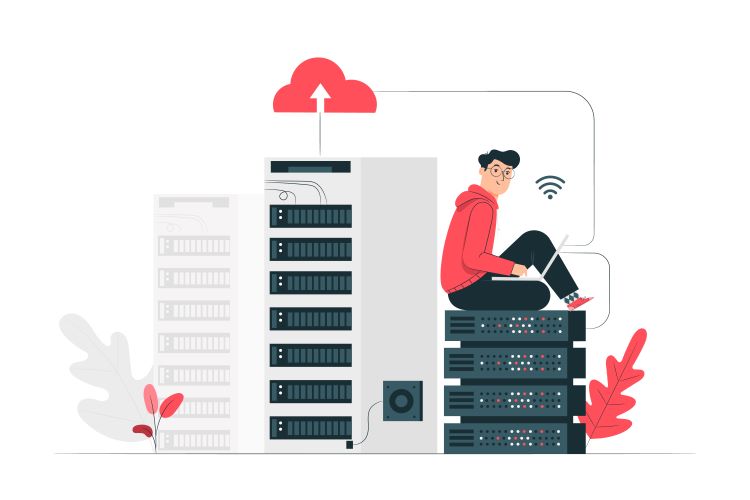For businesses and individuals looking for a reliable and secure web presence, Virtual Private Server (VPS) hosting is a popular option.
It offers many benefits, such as improved performance, flexibility, and control, but it also comes with its own set of challenges.
Knowing how to troubleshoot common VPS hosting issues is crucial for maintaining a seamless online experience.
In this comprehensive guide on Common Issues in VPS Hosting, we will discuss the most common issues with VPS hosting and provide practical solutions to address them.
By the end, you should be well-equipped to handle any VPS-related challenges and ensure a smooth hosting experience with Binary Racks.
What is VPS Hosting?
VPS hosting is a type of web hosting that provides a dedicated server-like environment using a virtual private server. Essentially, it creates a private, isolated space for your website or application within a physical server, offering more flexibility, control, and resources than shared hosting at a lower cost than a dedicated server.
With root access, you can customise the operating system, software, and configurations, making VPS an ideal choice for businesses needing a scalable, secure, and reliable hosting solution.
VPS Hosting Issues: Troubleshooting Guide
1. Resolving Server Performance Challenges
Achieving optimal server performance is critical for maintaining a responsive website and enhancing user satisfaction. Follow these steps to troubleshoot and address performance challenges:
Monitor Resource Usage
Utilise robust server monitoring tools to track CPU utilisation, memory consumption, disk space usage, and network activity. This helps pinpoint resource bottlenecks causing performance slowdowns.
Optimise Website and Server
Review and optimise your website’s code, enable compression, utilise caching mechanisms, and optimise image sizes to reduce server load. On the server side, disable unnecessary services and fine-tune configurations to align with your application’s requirements.
Upgrade VPS Plan
Consider upgrading to a higher-tier VPS plan with increased CPU cores, memory, and storage capacity if your current resources are insufficient for handling website traffic demands effectively.
Leverage Content Delivery Networks (CDNs)
Implement CDNs to distribute content across global servers, reducing the workload on your VPS and enhancing website loading speeds.
2. Troubleshooting Connectivity Issues
Ensuring stable connectivity is crucial for uninterrupted VPS operation. Follow these steps to diagnose and resolve connectivity issues:
Verify Network Configuration
Double-check VPS network settings, including IP addresses, subnets, and gateways, ensuring correct configuration. Review firewall settings to allow legitimate traffic.
Test Network Speed and Latency
Utilise network testing tools to assess speed and latency between your VPS and other locations. Identify and mitigate bottlenecks impacting connectivity.
Seek Support from Hosting Provider
If persistent network issues arise, contact your hosting provider’s support team to investigate and resolve infrastructure-related connectivity problems.
3. Enhancing VPS Security Measures
Safeguarding your VPS against security threats is paramount for protecting data integrity and ensuring user trust. Follow these steps to bolster VPS security:
Keep Software Updated
Regularly update operating systems, web servers, content management systems (CMS), and applications to patch known vulnerabilities and minimise the risk of unauthorised access.
Implement Strong Access Controls
Enforce robust password policies, utilise password managers, and consider implementing two-factor authentication (2FA) to strengthen access security.
Configure Firewall and Security Protocols
Deploy and configure a robust firewall to block malicious traffic effectively. Regularly review and update firewall rules to counter evolving security threats.
Perform Regular Security Audits
Conduct periodic security scans and audits to identify and mitigate potential vulnerabilities in your VPS configuration proactively.
4. Optimising Resource Allocation Strategies
Efficient resource allocation is essential for maintaining optimal VPS performance and preventing service interruptions. Follow these steps to optimise resource utilisation:
Monitor Server Workload
Monitor CPU load, memory usage, disk I/O operations, and network traffic patterns to identify resource-intensive processes.
Adjust Resource Allocation
Consider scaling resources up or migrating to a higher-tier VPS plan if your current configuration consistently reaches resource limits.
Fine-tune Applications and Databases
Optimise application performance by indexing databases, implementing caching mechanisms, and optimising query execution plans for improved efficiency.
Utilise Monitoring Tools
Leverage VPS provider’s monitoring tools or third-party solutions to gain insights into resource usage trends and identify areas for optimization.
5. Addressing Software Compatibility and Configuration Challenges
Ensuring software compatibility and proper configuration is crucial for seamless VPS operation. Follow these steps to troubleshoot and resolve software-related issues:
Verify Compatibility
Before installation or upgrades, verify software compatibility with your VPS’s operating system, web server, and other installed applications.
Review Configuration Settings
Ensure all software and server configurations are optimised and adhere to best practices to prevent performance degradation and security vulnerabilities.
Explore Alternative Solutions
Consider alternative software solutions that better suit your VPS environment if compatibility issues persist or limitations are encountered.
Backup Before Making Changes
Always create backups before making significant software or configuration changes to facilitate quick restoration in case of unforeseen issues or failures.
6. Considering an Upgrade
As your website grows and evolves, your current VPS plan might not suffice. Whether it’s due to increased traffic, the need for more storage, or enhanced security requirements, there comes a time when upgrading your VPS hosting plan is essential.
Here are some signs it might be time for an upgrade:
- Persistent Performance Issues: If you’ve optimised everything but still face slow load times or downtime, it’s time for more resources.
- Increased Traffic: More visitors require more bandwidth and processing power to serve them efficiently.
- Enhanced Security Needs: As your site grows, it becomes a bigger target for attacks, necessitating stronger security measures.
- Storage Limits: High-quality content and user data can quickly consume space. If you’re constantly nearing your storage capacity, consider a VPS or cloud hosting plan with more room.
Remember, the goal of VPS hosting is to provide a stable, scalable, and secure environment for your websites. Regularly assess your hosting plan against your current needs and future goals. Upgrading your VPS hosting plan can be a strategic investment in the future of your online presence.
Why Opt for a Virtual Private Server (VPS) from Binary Racks
Binary Racks Virtual Private Servers offer affordable hosting plans powered by KVM virtualization and SSD storage arrays for optimal performance.
These VPS plans support a variety of guest operating system templates, including CentOS, Debian, and Ubuntu.
Key Features
Total Control
Enjoy complete control over your VPS with full root access via SSH, along with dedicated IPv4 and IPv6 addresses. Customise your virtual server to meet your needs and dynamically adjust RAM, CPU, and storage resources as required.
Global Data Centers
Binary Racks provides hosting services at multiple data centers strategically located between Europe, Asia, and the Middle East, ensuring optimal connectivity and performance.
Advanced Virtualization
KVM virtualization platform offers significant performance benefits, including reduced I/O latency and no proxy architecture. This setup ensures users get the most out of their OS, utilising only high-performance server components.
High-Performance SSDs
Experience low latency and high performance with SSD storage arrays. Binary Racks storage servers are loaded with SSD drives designed for applications requiring high I/O throughput.
Fast Data Connections
Binary Racks data centers are connected to the internet backbone via multiple high-speed fiber data lines, ensuring high availability. The Binary Racks team monitors data center and network operations 24/7/365.
Expert Technical Support
Binary Racks technical support team is customer-focused, friendly, and available 24/7 via live chat, phone, or email. They can assist with various server-related issues, including software updates, security settings, and firewall configurations.
Choosing Binary Racks for your VPS hosting ensures a powerful, flexible, and reliable solution tailored to support your online presence and business growth.
Conclusion
Maintaining a smooth-running VPS involves a variety of tasks, from server setup and resource allocation to security configuration and data management. The solutions and tools discussed in this article on Common Issues in VPS Hosting are designed to help you tackle common issues, ensuring your digital presence remains strong and secure.
FAQ: Common Issues in VPS Hosting
Which VPS provider is the best?
When it comes to best VPS providers, Binary Racks is the best choice. They offer top-tier performance with advanced hardware and SSD storage, ensuring fast and efficient server performance. Their 99.99% uptime guarantee and advanced security features provide reliability and peace of mind. With flexible scaling options and 24/7 dedicated customer support, Binary Racks delivers a powerful, secure, and reliable hosting solution tailored to your business needs.
What should I look for in a VPS hosting?
- Performance and Resources: Adequate CPU, RAM, and storage (preferably SSD) & Sufficient bandwidth.
- Scalability: Easy upgrade options.
- Uptime and Reliability: 99.9% uptime guarantee.
- Security: DDoS protection, firewalls, regular backups & SSL certificates.
- Control Panel: User-friendly options like cPanel or Plesk.
- Operating System Options: Supports needed OS (Linux, Windows).
- Pricing: Competitive pricing with no hidden fees.
How do I optimize my VPS server?
Monitor Resources: Use tools to track CPU, RAM, disk usage, and network activity.
Web Server Optimization: Enable compression and caching & optimize server configurations.
Database Optimization: Tune settings and perform regular maintenance.
Application Optimization: Optimize code and minify files.
Use a CDN: Improve global load times.
Enhance Security: Implement firewalls and update software & use tools like Fail2ban.
Regular Updates and Maintenance: Keep software up to date and clean up unused files.
Optimize Resource Usage: Disable unnecessary services & Use swap space effectively.
Why is my VPS so laggy?
- Resource Overload: Check and upgrade CPU, RAM, or disk space.
- Unoptimized Applications: Review and optimize code and queries.
- Network Issues: Test connection and contact provider if needed.
- Heavy Traffic: Consider load balancing or upgrading your plan.
- Disk I/O Bottlenecks: Optimize disk usage and consider SSD storage.
- Security Threats: Implement security measures and scan for threats.
- Software Configuration: Adjust configurations for efficiency.
- Hosting Provider Issues: Contact provider for support if other factors are ruled out.








